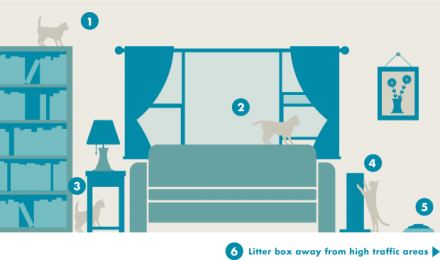1/Perches
In nature, cats often take to the trees. This keeps them hidden from predators, and gives them just the right vantage for surveying their territory and opportunistic hunting.
How can you introduce these elements to your home?
You may already have some nice architectural features or furniture to work with. Fireplace mantels, tall bookcases, wall shelves, even the back of a sofa or chair can serve this purpose.
Your cat gets to show off both natural agility and grace to get up and down. Plus it brings him or her a sense of comfort by getting up off the floor.
If furniture is off limits, you can increase the vertical space in your home with cat trees or cat clouds. These are cleverly designed climbing structures and wall shelves made especially for felines.
2/Connecting to the Outdoors
Because of the dangers associated with cars, exposure to disease from prey, and conflicts with wild or domestic animals, we don't condone outdoor cats. That's not to say indoor cats must be sealed off completely from the outside world.
Beyond supervised outdoor activities like leash walking, it's important to provide your cat with a place to interact with his or her surroundings. This can be through a window or door, even a screen porch. It's healthy to see and hear birds and other wildlife, as well as people and pets in the neighborhood. As is smelling new smells.
3/Hideouts
While roaming their home territory, it's quite common for cats in nature to hide in abandoned burrows or conceal their presence in a canopy of foliage.
There are many interesting options available that play into your cat's desire to see without being seen. Play tunnels are made of insulating fabric and can double as a bed. Some end tables have an enclosure that hides a cat bed inside. How about an indoor structure that's a cat's interpretation of a doghouse?
Your cat may already spend time under your bed or behind the sofa. But here are some other low-cost ways to achieve the same effect: pull books towards the front of a shelf to create a hiding space behind them. Or place a basket on end on the bottom shelf of an end- or coffee table to create a little cave. You can even drape a blanket or towel over a table to make a fort like when you were a kid.
4/Scratch Posts
Scratching is in your cat's nature, so it's important to give him or her an alternative to your furniture, rugs or curtains.
Cats in nature will use both standing and fallen trees for scratching in order to keep claws fit for climbing, hunting and self-defense. So a sturdy scratch post or horizontal surfaces can be used to replicate this activity. They can be made from corrugated cardboard, carpets or natural rope fibers.
5/Feeding
To create a calm environment for feeding, consider the type of dish you're using and where you place it.
Since your cat uses whiskers for navigating, communicating, and measuring the width of openings, a dish that causes his or her whiskers to bend can be irritating. Instead, use a plate or a shallow dish with short sides. This way, your cat can grab bits of kibble without touching his or her whiskers.
As for placement, it's important to understand the pressures of feeding in the wild. Active hunters know the value of a meal, so they stay alert for rivals coming in to steal the kill. Factor in that cats are quite vulnerable while eating, it's easy to realize why they can be jumpy at mealtime.
In your home, it may be another cat that puts him or her on edge. Perhaps it's a dog or a young child. So rather than placing the feeding dish in a corner, try putting it more out in the open. This can put your cat at ease by giving clear views of the space around him or her and access to more avenues of escape. Both of which appeal to your cat's instincts.
6/Litter Box
Sometimes, cats in nature want their presence to be known. Other times, they prefer to keep it hidden. But the fact is, every time a cat goes to the bathroom, they leave a trail of scent that can serve as a means of communication. So it's not uncommon to relieve themselves in different locations, and reserve specific spots for specific duties.
That said, here are our guidelines for litter boxes. You'll want one litter box for every cat in the house plus one extra; or one on each level of your home, even if you have one cat. This helps prevent territorial behavior, and allows for flexibility of use. Also, be mindful of placing your litter boxes in a quiet place that doesn't get much traffic. Even cats appreciate a little privacy.

